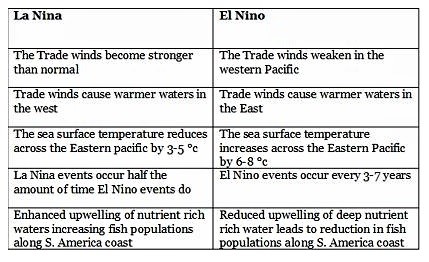- Courses
- GS Full Course 1 Year
- GS Full Course 2 Year
- GS Full Course 3 Year
- GS Full Course Till Selection
- Answer Alpha: Mains 2025 Mentorship
- MEP (Mains Enrichment Programme) Data, Facts
- Essay Target – 150+ Marks
- Online Program
- GS Recorded Course
- Polity
- Geography
- Economy
- Ancient, Medieval and Art & Culture AMAC
- Modern India, Post Independence & World History
- Environment
- Governance
- Science & Technology
- International Relations and Internal Security
- Disaster Management
- Ethics
- NCERT Current Affairs
- Indian Society and Social Issue
- NCERT- Science and Technology
- NCERT - Geography
- NCERT - Ancient History
- NCERT- World History
- NCERT Modern History
- CSAT
- 5 LAYERED ARJUNA Mentorship
- Public Administration Optional
- ABOUT US
- OUR TOPPERS
- TEST SERIES
- FREE STUDY MATERIAL
- VIDEOS
- CONTACT US
El Nino in 2023
El Nino in 2023


Latest Context
The equatorial Pacific area has recently seen the formation of an uncommon phenomena, which predicts the advent of El Nino conditions in 2023. According to experts, the simultaneous warming of the equatorial Pacific's eastern and western areas, a tendency that was last seen in 2009, might have detrimental effects on marine species all around the world.
Causes of this Phenomenon
- As the eastern Pacific warms, the west should get colder.
- However, the tropical Pacific is warming on a basin-scale as a result of global warming.
- This phenomenon may have been caused by one of two things:
- Pacific Ocean warming and other types of natural variability
- The cycle of the El Nino-Southern Oscillation (ENSO) wherein a La Nina winter gives way to an El Nino summer.
Basin Scale Warming in the Equatorial Pacific:
- The equatorial Pacific receives basin-scale warming as a result of global warming, affecting both the eastern and western areas.
- Basin size is a term used to describe the geographic scope of a basin or shared water outflow, in this example, the equatorial Pacific area.
- Recent data study reveals that May 29, 2023's ocean temperatures were out of the ordinary warm compared to the norm between 2003 and 2014.
What is ENSO?
- The ENSO is a recurring climatic pattern involving temperature changes in the waters of the eastern and central tropical Pacific Ocean, and changes in the patterns of upper and lower-level winds, sea level pressure, and tropical rainfall across the Pacific Basin.
Possible Consequences of this Phenomenon
Global Warming:
- The end of La Nina indicates that heat is not being absorbed by the ocean, which will cause it to escape into the atmosphere.
- The water loses less heat if the atmosphere is warmer, which causes the ocean to warm up near the surface.
- This might temporarily increase global warming above 1.5°C.
Geophysical Effect:
- Typhoon Mawar, which is now one of the strongest in the western Pacific, is one of the strongest typhoons that would be affected by the phenomena.
- The sluggish meridional circulation caused by rising ocean waters, which acts as a stimulant for marine heatwaves, might result in irreversible losses to marine biodiversity.
Coral Bleaching:
- A 2°C increase would result in a loss of nearly 100% of coral reefs, which would be irreversible with a temperature of 1.5°C.
Previous El Nino Events:
- The most severe El Nino episodes of the 20th century were those of 1982–1983, and 1997–1998.
- Sea surface temperatures in the eastern tropical Pacific were 9–18° F above average during the 1982–1983 period.
- The El Nino event of 1997–1998 was the first El Nino to be thoroughly studied from start to finish.
- Drought conditions were brought on by the 1997–1998 incident in the Philippines, Malaysia, and Indonesia. Extremely strong rainfall and serious flooding were observed in Peru and California.
- The "year without a winter" was a time when temperatures in the Midwest broke records for warmth.
- El Nino and climate change combined to make 2016 the warmest year on record.
What effects will El Nino 2023 have on India?
Weak Monsoon for India:
- The southwest monsoon season, which produces around 70% of the total rainfall India receives and on which the majority of its farmers still depend, may decline if an El Nino develops in May or June 2023.
- The Madden-Julian Oscillation (MJO) and monsoon low-pressure systems, however, can momentarily increase rainfall in some areas, as was the case in 2015.
Hot Temperatures:
- In India as well as other places like South Africa, Australia, Indonesia, and the Pacific Islands, it may also bring about heatwaves and droughts.


Prelims
Q. With reference to ‘Indian Ocean Dipole (IOD)’ sometimes mentioned in the news while forecasting Indian monsoon, which of the following statements is/are correct? (2017)
1.IOD phenomenon is characterised by a difference in sea surface temperature between tropical Western Indian Ocean and tropical Eastern Pacific Ocean.
2.An IOD phenomenon can influence an El Nino’s impact on the monsoon.
Select the correct answer using the code given below:
(a) 1 only
(b) 2 only
(c) Both 1 and 2
(d) Neither 1 nor 2
Ans: (b)
Mains
Q. Most of the unusual climatic happenings are explained as an outcome of the El-Nino effect. Do you agree? (2014)



